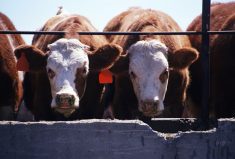Compared to last week, Western Canadian yearling prices were steady to $5 higher. Across the prairies, strong demand was noted on limited offerings. Most auction barns are gearing up for major sales over the next couple weeks; however, it appears that a few ranchers were testing the waters and the results were quite surprising. Feedlot operators are anxious to reload given the prolonged period of positive margins. Larger sales attracted the attention of major feedlot operators. In East Central Alberta, mixed steers averaging 875 pounds averaged $195. In Southern Alberta, medium to larger frame steers with lower flesh levels averaging 825 pounds were quoted from $196 to $200. Yearling prices have divorced from the fed cattle market for the time being which is not uncommon early in the fall run.
Read Also

U.S. livestock: Cattle futures end higher on cold weather, rising cash prices
Chicago | Reuters – Chicago Mercantile Exchange (CME) cattle futures closed higher on Thursday for the third straight session, as…
The calf market was quite variable depending on the region. Central and Southern Alberta markets were unchanged from last week but moving east, prices were softer trading $5 to as much as $10 lower. The southern half of Saskatchewan has seen pastures deteriorate due to above normal temperatures and limited precipitation; buyers were hesitant to step forward because lower prices are expected later this fall as volumes increase. Feedlots and backgrounding operators were on the sidelines which left the market contending with lower demand. Small packages of mixed steers from 725 to 750 pounds were quoted from $205 to $215 across Alberta; in Central Alberta, a small group of larger frame mixed steers averaging 550 pounds sold for $244 while mixed heifers averaging 525 pounds sold for $225.
Southern Alberta barley prices were quoted from $195/mt to $200/mt. Cattle feeders are incorporating a risk discount on the lighter feeders because the fundamental structure for feed barley is expected to be historically tight for the 2017-18 crop year. The cost per pound gain will increase later in winter when these cattle move on full feed rations and this also has buyers on the defensive.















